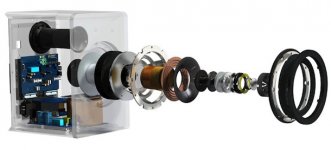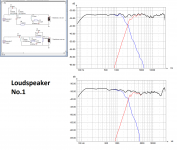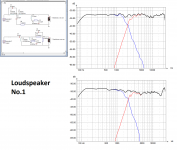Hey there,
Kind of off-topic, but I need your opinion. I've got a pair of KEF X300A that aren't working any more. Apparently there is an issue with the power board. According to some comments on the internet, it's an expensive replacement that's probably not worth it.
I'm now wondering what I could do with them, I'm neither an audio nor electronics nerd (besides basic stuff). Does it make sense/is it possible to use them as passive speakers somehow?
I'm thinking about replacing them and wonder with what. I've used them as Desktop speakers, the sound is excellent. But I'm not sure if I want to use active speakers any more, don't want to throw them away again if they break.
Anyone got an idea?
Thanks a lot!
Kind of off-topic, but I need your opinion. I've got a pair of KEF X300A that aren't working any more. Apparently there is an issue with the power board. According to some comments on the internet, it's an expensive replacement that's probably not worth it.
I'm now wondering what I could do with them, I'm neither an audio nor electronics nerd (besides basic stuff). Does it make sense/is it possible to use them as passive speakers somehow?
I'm thinking about replacing them and wonder with what. I've used them as Desktop speakers, the sound is excellent. But I'm not sure if I want to use active speakers any more, don't want to throw them away again if they break.
Anyone got an idea?
Thanks a lot!
So, you're talking about a KEF Uni-Q driver: 5.25" bass/midrange driver and 1" tweeter.
To run the Uni-Q from an external amplifier you would need to introduce a passive crossover to divide the frequencies between the bass/mid and tweeter sections.
I think the best idea would be to request suggestions for a suitable passive crossover schematic in the "Loudspeakers: Multi-Way" section of the forum.
To run the Uni-Q from an external amplifier you would need to introduce a passive crossover to divide the frequencies between the bass/mid and tweeter sections.
I think the best idea would be to request suggestions for a suitable passive crossover schematic in the "Loudspeakers: Multi-Way" section of the forum.
Just put a 100 uF / 25V as the tweeter crossover, and put both speakers on parallel.
The positive wire goes to capacitor positive, capacitor negative to tweeter positive.
Tweeter negative to speaker negative.
Full range / larger speaker connected directly.
Connect to a suitable amplifier, or make one...that is a vast subject.
But a 20W/channel/8R amp should be good enough.
The positive wire goes to capacitor positive, capacitor negative to tweeter positive.
Tweeter negative to speaker negative.
Full range / larger speaker connected directly.
Connect to a suitable amplifier, or make one...that is a vast subject.
But a 20W/channel/8R amp should be good enough.
Or 47, polar
Apparently works as a DC blocker too, and much cheaper I think compared to film.
You can put a smaller one too, I suppose, to match piezo tweeters, here they are 1" coils I think.
So a larger one would be more appropriate.
Or he can simply see what has been used to drive them in the original circuit, I suspect there was an a single amp in the powered speaker driving both drivers. That would be the correct value.
Apparently works as a DC blocker too, and much cheaper I think compared to film.
You can put a smaller one too, I suppose, to match piezo tweeters, here they are 1" coils I think.
So a larger one would be more appropriate.
Or he can simply see what has been used to drive them in the original circuit, I suspect there was an a single amp in the powered speaker driving both drivers. That would be the correct value.
Last edited:
If the Uni-Q driver in the passive KEF LS50 is anything to go by, we are looking at a tweeter crossover frequency of 2.2 kHz (slope unknown) and impedance 4 ohm.
To err on the safe side, I'd put no larger than an 8.2 uF film capacitor in series with the 1" (coil-type) tweeter driver while letting the 5.25" mid/bass driver run direct.
8 2 fd Monacor MKP Capacitor
To err on the safe side, I'd put no larger than an 8.2 uF film capacitor in series with the 1" (coil-type) tweeter driver while letting the 5.25" mid/bass driver run direct.
8 2 fd Monacor MKP Capacitor
Attachments
Please, serious suggestions only.
That is a high quality biamped system, the LEAST it deserves is a generic 12 dB/oct passive crossover, at 2500Hz .
Such as:
Dayton Audio XO2W-2.5K 2-Way Speaker Crossover 2,500 Hz
this one might be overkill, is more for a PRO, high power speaker, lamp protected, etc, but hey ....
Eminence PXB2:2K5CX 2-Way Speaker Crossover Board 2,500 Hz
Tweeter probably needs some attenuation to match woofer , most general purpose crossovers include that, and afterwards they can be tweaked for even better response, but even with an generic one, they should already sound VERY good.
You might even find a generic biamp backplate roughly matching original amps, for a reasonable price.
Or build your own if you dare.
Only problem is that both cabinets will sound different, worst case both should be turned passive and fed from your current Stereo power amp.
Original spec is:
*50W RMS for woofer
* 20W RMS for tweeter
* 2500 Hz active X Over
As a practical example, not-the-same-but-close-enough, I am into Musical Instrument amplification and of course assist to tons of live shows, many in small Clubs,Theaters, public parks, etc.
So PA providers are often local small "companies" , not Mega Stadium sized ones, and more and more I see them use mountains of "good brand" but haphazardly random mix cabinets, I mean JBL, RCF,Yamaha, Mackie, etc.
When I look at their backs, MANY (most?) show a plywood rectangle covering original backplate amp cavernous hole, some leave the original plate, including heatsinks , but just as a cover, often with pots/knobs/switches/IEC connectors removed but all sporting a couple Speakon connectors and of course an inside mounted passive crossover.
Typically driven by a generic/classic rack type amp, anything from a heavy but indestructible Peavey CS800 to various "good" brands (AB Systems, QSC, etc.) to cheapies such as "DJ" type amps "Pyramid, Numark, Soundtech, etc.) to "mystery brands".
The best part?
ALL "sound good" and definitely save the day.
That is a high quality biamped system, the LEAST it deserves is a generic 12 dB/oct passive crossover, at 2500Hz .
Such as:
Dayton Audio XO2W-2.5K 2-Way Speaker Crossover 2,500 Hz
this one might be overkill, is more for a PRO, high power speaker, lamp protected, etc, but hey ....
Eminence PXB2:2K5CX 2-Way Speaker Crossover Board 2,500 Hz
Tweeter probably needs some attenuation to match woofer , most general purpose crossovers include that, and afterwards they can be tweaked for even better response, but even with an generic one, they should already sound VERY good.
You might even find a generic biamp backplate roughly matching original amps, for a reasonable price.
Or build your own if you dare.
Only problem is that both cabinets will sound different, worst case both should be turned passive and fed from your current Stereo power amp.
Original spec is:
*50W RMS for woofer
* 20W RMS for tweeter
* 2500 Hz active X Over
As a practical example, not-the-same-but-close-enough, I am into Musical Instrument amplification and of course assist to tons of live shows, many in small Clubs,Theaters, public parks, etc.
So PA providers are often local small "companies" , not Mega Stadium sized ones, and more and more I see them use mountains of "good brand" but haphazardly random mix cabinets, I mean JBL, RCF,Yamaha, Mackie, etc.
When I look at their backs, MANY (most?) show a plywood rectangle covering original backplate amp cavernous hole, some leave the original plate, including heatsinks , but just as a cover, often with pots/knobs/switches/IEC connectors removed but all sporting a couple Speakon connectors and of course an inside mounted passive crossover.
Typically driven by a generic/classic rack type amp, anything from a heavy but indestructible Peavey CS800 to various "good" brands (AB Systems, QSC, etc.) to cheapies such as "DJ" type amps "Pyramid, Numark, Soundtech, etc.) to "mystery brands".
The best part?
ALL "sound good" and definitely save the day.
Last edited:
Yes, JMF, I realise this, and that is why I suggested that the OP ask for a crossover schematic over in the "Multi-Way" section.Please, serious suggestions only.
That is a high quality biamped system, the LEAST it deserves is a generic 12 dB/oct passive crossover, at 2500Hz .
However, I felt I just had to counter the strange suggestion of using a 100 uF polarised capacitor in series with the tweeter!
Well, 4.7uF is DEFINITELY better than mind blowing 47uF but in any case, those speakers are not much of an example, car speakers, specially generic cheapies, are bottom of the barrel as far as speakers go.
As of real crossovers, Zvu´s work is IMPRESSIVE but I also agree that it´s somewhat too much for a "normal" user such as Blach, including the difficulty of sourcing all those various values inductors
Unless somebody is offering the ready built crossover as a straight drop-in option.
Lacking that, I repeat my suggestion of using a store bought crossover at the right frequency, it will be much better than a crude simple cap .
Doubly so because two will be needed.
DIY Audio is an open Forum, and suggestions can go from crude to ultra sophisticated, I tend to travel along the middle of the road.
To each his own
As of real crossovers, Zvu´s work is IMPRESSIVE but I also agree that it´s somewhat too much for a "normal" user such as Blach, including the difficulty of sourcing all those various values inductors
Unless somebody is offering the ready built crossover as a straight drop-in option.
Lacking that, I repeat my suggestion of using a store bought crossover at the right frequency, it will be much better than a crude simple cap .
Doubly so because two will be needed.
DIY Audio is an open Forum, and suggestions can go from crude to ultra sophisticated, I tend to travel along the middle of the road.
To each his own
Perhaps blach is more interested in suggestions for passive replacements rather than converting his (once) active speakers to passive use?Does it make sense/is it possible to use them as passive speakers somehow?
I'm thinking about replacing them and wonder with what.
I note he has not yet responded to any of our posts.
I think the speaker amps might be repairable?
Or at least the existing crossovers can be inspected as a guide.
The simplest repair would be to attach the speaker input cables at the amplifier outputs inside the speaker, turning them passive...I think the crossovers will be after the amp output stage.
Easy enough to do...This will allow the use of another external amplifier.
Or at least the existing crossovers can be inspected as a guide.
The simplest repair would be to attach the speaker input cables at the amplifier outputs inside the speaker, turning them passive...I think the crossovers will be after the amp output stage.
Easy enough to do...This will allow the use of another external amplifier.
Maybe, but Blach apparently can´t do that, he spoke of "expensive replacements" only.I think the speaker amps might be repairable?
No "existing crossovers", that speaker is active.Or at least the existing crossovers can be inspected as a guide.
You can NOT attach an external amplifier to an internal amplifier *output*.The simplest repair would be to attach the speaker input cables at the amplifier outputs inside the speaker,
you will blow the external amplifier too.turning them passive...
again, no internal (passive) crossover.I think the crossovers will be after the amp output stage.
Speakers pecs are :
Original spec is:
*50W RMS for woofer
* 20W RMS for tweeter
* 2500 Hz active X Over
That said, Blach left long ago, even before post#3 was published.
This thread is more of a guide for others with a similar problem.
PS: judging from post history, blach is way more into the digital/software/computing realm than into hardcore Analog component level repairs/building.
Ok, to each his own
That said, I guess buying a ready made passive crossover board and wiring it to speaker components will be the shortest path to reclaiming the speakers.
And he already expressed distrust in active speaker solutions, even if buying new ones.
Last edited:
An active speaker is one with a built in amplifier, right?
So, if the drivers work, I can remove the amplifier inside, and use an external amp to drive the speakers.
Question is crossover, the existing amp had either one output and a crossover, or two amplifiers with the crossover on the input side, one for each driver.
Based on the that, a possible salvage can be attempted.
That is my conclusion.
Anyway, as in many cases, the OP has not responded, on to the next problem!
So, if the drivers work, I can remove the amplifier inside, and use an external amp to drive the speakers.
Question is crossover, the existing amp had either one output and a crossover, or two amplifiers with the crossover on the input side, one for each driver.
Based on the that, a possible salvage can be attempted.
That is my conclusion.
Anyway, as in many cases, the OP has not responded, on to the next problem!
Last edited:
- Home
- General Interest
- Everything Else
- Dead KEF X300A - what to do with them?


